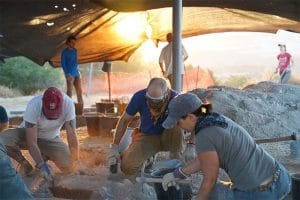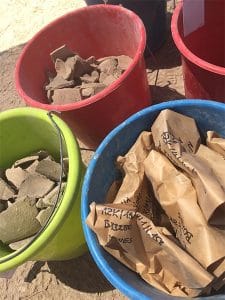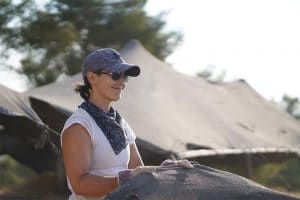
HOW TO UNEARTH A POT (AKA HOW TO WORK ON A TEAM)
Lisa J. Cleath, 2019 William G. Dever Fellowship Recipient
Coming into the Dever Fellowship, I knew two things for certain: first, real archaeology is nothing like it appears to be in the Indiana Jones films, and second, I am not an archaeologist. Nevertheless, I knew I could learn a tremendous amount about archaeology in four weeks digging at Tel Azekah and four weeks at the Albright Institute, and my summer did not disappoint.
All in all, I gained a great respect for the archaeologists I encountered, as I learned about the methods that they meticulously employ in the field and in their research. It was a particular privilege to work alongside them in the field at Azekah, where I could gain firsthand instruction from the experienced and generous area supervisors. Under the friendly shade nets, we labored together in the dirt so that I could learn when to use the masterinas,* when we needed to sift the buckets of dirt to look for tiny finds, and when to signal changes in dirt color to the supervisors.

Since I often teach about biblical history in my courses, I was most excited to excavate a destruction layer from Sennacherib’s 701 campaign in Judah.** Within the first few days, we came upon a plaster floor onto which a bunch of pottery had been crushed during the 701 destruction of Azekah. The discovery of this pottery assemblage offered the opportunity for me to be trained in the techniques archaeologists currently use to document, unearth, and test (relatively) whole vessels. As the area supervisor explained to me, the science that archaeologists use is constantly changing as they gain more advanced techniques to understand their finds. I came to understand that even within this single excavation, different archaeologists would have different takes on how specifically to document and preserve a vessel – so that at any given time, I needed to be in communication with the team members about the expectations of the moment.

Joining a dig felt like being welcomed into a family. I can’t express enough how lucky I feel to have received this fellowship, and can’t wait to use my newfound knowledge in my teaching and research.
*masterina was a daily part of the dig language at Azekah’s N1 area; we were told that it comes from the Arabic word for “trowel.”
**See 2 Kings 18-19 to see how this event interfaces with the biblical narrative.
Lisa J. Cleath is Assistant Professor of Biblical Studies at George Fox University in Newberg, OR. Her research focuses on Second Temple Judaism, including postcolonial readings of Jewish diaspora communities, epigraphic studies of the Aramaic documents from Elephantine Island, and ideologies of authoritative text in biblical narratives.
American Society of Overseas Research
The James F. Strange Center
209 Commerce Street
Alexandria, VA 22314
E-mail: info@asor.org
© 2023 ASOR
All rights reserved.
Images licensed under a Creative Commons Attribution-NonCommercial-ShareAlike 4.0 International License
COVID-19 Update: Please consider making payments or gifts on our secure Online Portal. Please e-mail info@asor.org if you have questions or need help.
